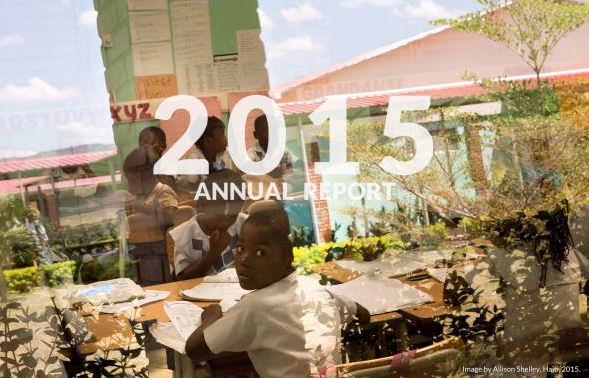
OUR ANNUAL REPORT
As our Board Chair Emily Rauh Pulitzer and Executive Director Jon Sawyer note, it was 10 years ago this month that the Pulitzer Center opened its doors, a one-person shop with a donated desk, modest seed funding, and high ambitions: to fill gaps in reporting and inspire a new generation of journalists to cover the big global issues that affect us all.
We've come a long way. In the past year we supported 113 reporting projects and held nearly 500 events with university, secondary and middle school partners. Reporting opportunities for 27 students from our Campus Consortium partners took place across the globe. New e-books, documentary films and social-media platforms allowed us to reach hundreds of thousands of people. These are among the highlights in our 2015 annual report, which is now available online.
IN IRAQ, A WAR AMONG TRIBES
For this vividly reported story in the current issue of The New Yorker, Pulitzer Center grantees Luke Mogelson and Moises Saman spent time with Kurdish, Yazidi and anti-ISIS Sunni fighters who are bogged down in the struggle to retake Iraqi territory from ISIS.
Sinjar, which had a Yazidi majority, is one town that has recently been taken back. Once home to a hundred thousand people, Sinjar—what's left of it—is now mostly deserted. Before retreating, ISIS burned down Yazidi houses, looted their shops, and blew up their religious shrines. Now Luke watched as the returning Yazidis looted the empty Sunni houses.
"No one I spoke with in Sinjar believed that Sunni civilians could have lived among the ISIS occupiers without collaborating in their crimes; nor could anyone imagine a future in which Yazidis and Christians would once again live in harmony with Sunnis. In Sinjar, it seemed that ISIS and Sunnism would forever be conflated," writes Luke.
"With so many rival factions and competing interests—and in the absence of a unifying national government or army (or identity)—what happens the day after a city in Iraq or Syria is liberated from ISIS? What happens a week after? A year?" he asks.
AN AVOIDABLE EPIDEMIC IN PHILIPPINES
While HIV/AIDS infection rates decline worldwide, the Philippines is on the verge of an epidemic. Since its first reported case in 1984, the country has been categorized "low-incidence," meaning less than 1 percent of the population is infected with HIV. Only 2,410 new HIV infections were recorded between 1984 and 2005.
But last year, health officials reported 29,079 HIV infections. "More than 24,000 of those cases were detected in just the last five years. At this current rate, the (Department of Health) predicts that the number of HIV infections in the Philippines could reach 133,000 by 2022," reports Pulitzer Center grantee Ana Santos in a story for The Atlantic.
Although most of the country's new infections come from sexual contact, Ana says that current policies—strongly influenced by the Catholic Church—can make it difficult for health workers to promote safe sex: Testing and contraceptives are off-limits to minors, for example, unless they have parental consent. Needle exchange programs for intravenous drug users are also against the law.
TARGETING KENYA'S ETHNIC SOMALIS
The ethnic Somalis from Kenya's far northeast have long existed on the country's margins, a result of ethnic and religious differences and a war to secede decades ago. Things have only gotten worse since a string of terror attacks claimed by al-Shabab, an al-Qaeda affiliate based in neighboring Somalia. It now seems Kenyan security forces may be retaliating against the Somali community.
"Suspicions have grown more intense since an attack in September 2013 on an upscale Nairobi mall, which left 67 dead, and an assault on Garissa University College in northeastern Kenya in April, which killed 148 people," writes Pulitzer Center grantee Ariel Zirulnick in her dispatch for The Washington Post.
"A growing number of Kenya's ethnic Somalis have vanished or turned up dead after being detained amid a crackdown by security forces on Islamist extremists. The authorities have denied involvement, suggesting many of the deaths are at the hands of al-Shabab," writes Ariel. "But parliamentarians representing the predominantly ethnic-Somali counties of northeast Kenya have said many of the victims are targets of a campaign by security forces."
Ariel's story has drawn wide notice in Kenya, with President Uhuru Kenyatta being grilled about it in public appearances over the weekend. "So, thank you for providing the funding that allowed me to get up there," Ariel told us. "Getting on the ground is what made people trust me, which allowed me to write a strong enough piece to get it in an outlet where it would get widely noticed, which means that it's actually having an impact here in Kenya."
AFGHANISTAN IN PEN AND INK
This week, grantee George Butler takes over our Instagram account. Follow us @pulitzercenter to see his illustrations of life in Afghanistan after the withdrawal of U.S. and British forces.
Until next week,
Tom Hundley
Senior Editor




